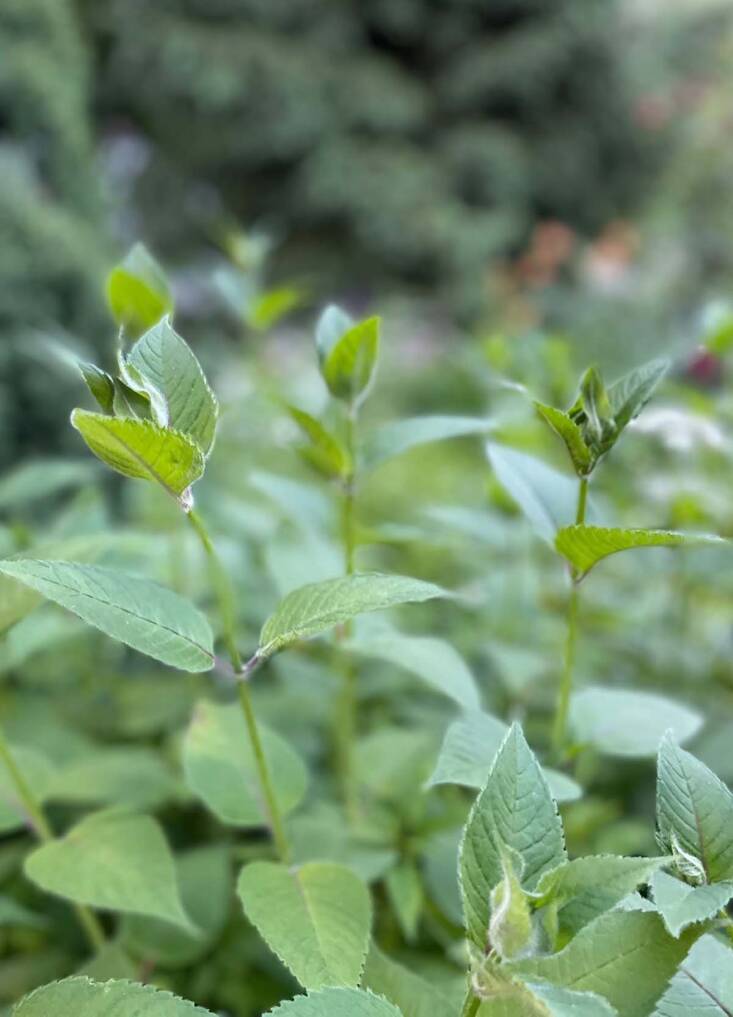As the dainty fireworks of bee balm flowers begin to erupt in summer, a time-lapse camera would reveal a growing and interactive crowd in motion. First a bee, then another, then a dozen. Honey, bumble, and carpenter. A butterfly, an iridescent fly. Sipping and dipping. Native American bee balm is well-known as a pollinator-pleasing perennial, but it offers even more: Its aromatic leaves and flowers are edible. With an exception (more about that later), bee balm tastes like a melding of oregano and summer savory, and can be used in exactly the same ways. It was used on this continent by Native American nations long before Mediterranean herbs crossed the Atlantic to please European palates. Growing bee balm is good not only for your biodiversity karma, but for your culinary adventures. Plus? It’s cold-hardy!
Ready to explore? Read on for growing tips and recipes for this North American herb.
Photography by Marie Viljoen.

Let’s talk names. Is it bee balm, or bergamot? Both. Bee balm is also known as wild bergamot, or bergamot. It is unrelated to the other bergamot, the fragrant fruit of Citrus bergamia, which perfumes Earl Grey tea (although both contain limonene in their essential oil). Bee balm is also known as Oswego tea, although that etymology is murky (Oswego is a place, but not a Native nation). Certainly, the plant was used as food, a medicinal tea, and a topical application by Native Americans.

Bee balm belongs to the genus Monarda, which comprises almost two dozen species. There are many more hybrids and named cultivars. Most bee balm plants at nurseries are either Monarda didyma (scarlet bee balm), Monarda fistulosa, or a hybrid of the two. Another bee balm, menthol-smelling M. punctata looks dramatically different, with petite flowers but very showy, whorled pink leaf bracts. Southern native M. citriodora smells similar, with a spicy finish. All bee balms sport the tufts of tubular flowers that mark them as members of the mint family, Lamiaceae, whose nectar is irresistible to our flying friends. Who does resist the attractions of bee balm? Deer.

Growing bee balm is simple if you give the plants good drainage, full sun, and room to move (they spread via runners, underground). Wet feet and a lack of air circulation can lead to the dreaded, mildewed leaves that can give bee balm a bad reputation.

Don’t plant bee balm with its back to a hot wall. The plants like to feel the breeze. When they send up their first shoots after winter dormancy, nip out their tips to encourage a bushier habit. The plants are hardy from USDA Zones 4 – 9.

In full summer bloom, and with tall stems, bee balm tends to flop after heavy rain, so meadowy companion plants can be very helpful, keeping the plant propped up for a few, drying hours. Species of Panicum (panic grass), Echinacea, Agastache, Helenium and various asters could all play supportive (pardon) roles.

After the first flush of blooms is spent, deadhead the flowers by cutting the stems back by about two-thirds. This encourages a second flush of (smaller) flowers in late summer or early fall. Either way, leave the seed heads on the plant through fall and winter. They are sculpturally appealing and also feed seed-eating birds.


So let’s talk food. And drink. If you have used oregano or summer savory, before, you know how to use bee balm. It’s that simple. A host of Native American nations has long used various species of bee balm as a culinary herb, drink, medicine, and even as a food preservative (thymol is antimicrobial). Bee balm is a truly North American herb.

When I slow-cook comfort foods like beans and pozole (both dishes native to this continent), bee balm often leads the herbal pack.

Summer grilling invites bee balm, and I often use the flowers, which are as aromatic as the leaves. Cook a foil-wrapped chunk of feta over coals for 30 minutes, and serve with your favorite flatbread or baguette.

Balm for the Bee
Bittersweet, smoky, and aromatic, this is a long drink to be savored.
- 2 oz mezcal
- 6 bee balm leaves
- 4 oz fresh-squeezed ruby grapefruit juice
- 2 oz Fever Tree Sparkling Pink Grapefruit
- 1 bee balm swizzle stick (stem with flower)
Muddle the mezcal with the bee balm leaves, and strain. Pour into a tall glass, adding the fresh grapefruit juice and Sparkling Pink Grapefruit. Stir gently with your bee balm swizzle stick, and top with ice cubes.

Bee Balm Caprese
Quick-pickling any stone fruits adds a level of savory intensity to their flavor. It’s also a great way to use slightly underripe fruit.
- 1 peach, peeled and sliced
- 1/4 cup white wine vinegar
- 2 Tablespoons sugar
- 1 teaspoon salt
- 2 Persian cucumbers, lightly crushed
- 6 snap peas, halved
- 1 ball burrata
- Flowers from 5 bee balm flower heads
- Nasturtium leaves (optional)
- 2 Tablespoons extra virgin olive oil
- Black pepper
In a bowl combine the peach slices with the vinegar, salt, and sugar. Muddle to dissolve salt and sugar. Allow to macerate for a minimum of 30 minutes, then drain (reserve the brine for other pickles). Assemble the salad by plating all the ingredients and scattering the bee balm flowers across the top. Drizzle some good extra virgin olive oil over the salad, season with freshly ground black pepper, and serve.
Happy growing and eating!
For more of Marie’s recipes, see:
- Green Fig Preserve Recipe: A Taste of South Africa
- Edible Nasturtiums: Pretty Powerhouses of Flavor
- How to Eat Passionfruit (Let Us Count the Ways)












Have a Question or Comment About This Post?
Join the conversation (0)